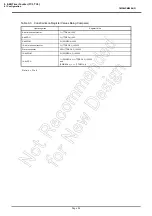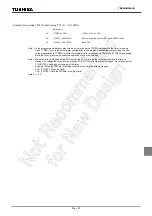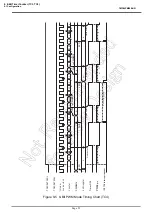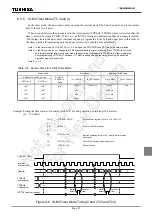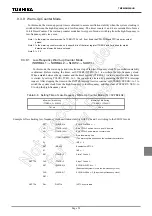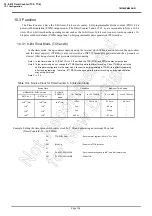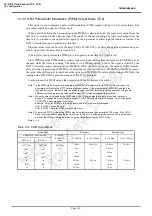
Page 99
TMP86PM29BUG
9.3.9
Warm-Up Counter Mode
In this mode, the warm-up period time is obtained to assure oscillation stability when the system clocking is
switched between the high-frequency and low-frequency. The timer counter 3 and 4 are cascadable to form a
16-bit TimerCounter. The warm-up counter mode has two types of mode; switching from the high-frequency to
low-frequency, and vice-versa.
Note 1: In the warm-up counter mode, fix TCiCR<TFFi> to 0. If not fixed, the
PDOi
,
PWMi
and
PPGi
pins may output
pulses.
Note 2: In the warm-up counter mode, only upper 8 bits of the timer register TTREG4 and 3 are used for match
detection and lower 8 bits are not used.
Note 3: i = 3, 4
9.3.9.1
Low-Frequency Warm-up Counter Mode
(NORMAL1
→
NORMAL2
→
SLOW2
→
SLOW1)
In this mode, the warm-up period time from a stop of the low-frequency clock fs to oscillation stability
is obtained. Before starting the timer, set SYSCR2<XTEN> to 1 to oscillate the low-frequency clock.
When a match between the up-counter and the timer register (TTREG4, 3) value is detected after the timer
is started by setting TC4CR<TC4S> to 1, the counter is cleared by generating the INTTC4 interrupt
request. After stopping the timer in the INTTC4 interrupt service routine, set SYSCR2<SYSCK> to 1 to
switch the system clock from the high-frequency to low-frequency, and then clear of SYSCR2<XEN> to
0 to stop the high-frequency clock.
Table 9-8 Setting Time of Low-Frequency Warm-Up Counter Mode (fs = 32.768 kHz)
Minimum Time Setting
(TTREG4, 3 = 0100H)
Maximum Time Setting
(TTREG4, 3 = FF00H)
7.81 ms
1.99 s
Example :After checking low-frequency clock oscillation stability with TC4 and 3, switching to the SLOW1 mode
SET
(SYSCR2).6
: SYSCR2<XTEN>
←
1
LD
(TC3CR), 43H
: Sets TFF3=0, source clock fs, and 16-bit mode.
LD
(TC4CR), 05H
: Sets TFF4=0, and warm-up counter mode.
LD
(TTREG3), 8000H
: Sets the warm-up time.
(The warm-up time depends on the oscillator characteristic.)
DI
: IMF
←
0
SET
(EIRH). 3
: Enables the INTTC4.
EI
: IMF
←
1
SET
(TC4CR).3
: Starts TC4 and 3.
:
:
PINTTC4:
CLR
(TC4CR).3
: Stops TC4 and 3.
SET
(SYSCR2).5
: SYSCR2<SYSCK>
←
1
(Switches the system clock to the low-frequency clock.)
CLR
(SYSCR2).7
: SYSCR2<XEN>
←
0 (Stops the high-frequency clock.)
RETI
:
:
VINTTC4:
DW
PINTTC4
: INTTC4 vector table
Summary of Contents for TLCS-870/C Series
Page 1: ...8 Bit Microcontroller TLCS 870 C Series TMP86PM29BUG ...
Page 6: ...TMP86PM29BUG ...
Page 7: ...Revision History Date Revision 2007 10 11 1 First Release 2008 8 29 2 Contents Revised ...
Page 9: ......
Page 15: ...vi ...
Page 19: ...Page 4 1 3 Block Diagram TMP86PM29BUG 1 3 Block Diagram Figure 1 2 Block Diagram ...
Page 23: ...Page 8 1 4 Pin Names and Functions TMP86PM29BUG ...
Page 48: ...Page 33 TMP86PM29BUG ...
Page 49: ...Page 34 2 Operational Description 2 3 Reset Circuit TMP86PM29BUG ...
Page 61: ...Page 46 3 Interrupt Control Circuit 3 8 External Interrupts TMP86PM29BUG ...
Page 81: ...Page 66 6 Watchdog Timer WDT 6 3 Address Trap TMP86PM29BUG ...
Page 135: ...Page 120 10 8 Bit TimerCounter TC5 TC6 10 1 Configuration TMP86PM29BUG ...
Page 145: ...Page 130 11 Asynchronous Serial interface UART 11 9 Status Flag TMP86PM29BUG ...
Page 165: ...Page 150 13 10 bit AD Converter ADC 13 6 Precautions about AD Converter TMP86PM29BUG ...
Page 183: ...Page 168 15 LCD Driver 15 4 Control Method of LCD Driver TMP86PM29BUG ...
Page 201: ...Page 186 18 Electrical Characteristics 18 9 Handling Precaution TMP86PM29BUG ...
Page 203: ...Page 188 19 Package Dimensions TMP86PM29BUG ...
Page 205: ......


